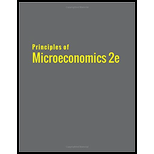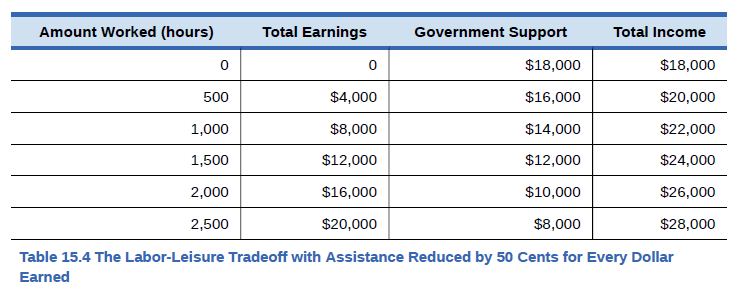
Jonathan is a single father with one child. He can work as a server for $6 per hour for up to

Trending nowThis is a popular solution!

Chapter 15 Solutions
PRINCIPLES OF MICROECONOMICS (OER)
Additional Business Textbook Solutions
Cost Accounting (15th Edition)
Managerial Accounting (4th Edition)
Horngren's Accounting (11th Edition)
Construction Accounting And Financial Management (4th Edition)
Horngren's Cost Accounting: A Managerial Emphasis (16th Edition)
Principles of Management
- Which of the following represents a transfer payment? O You transfer $1,000 from your bank account to a mutual fund. The government sends your grandfather his Social Security check. O You make a payment to get legal documents showing you purchased a previously owned home. Your employer automatically transfers $100 each month from your wages to a non-taxable medical spending account.arrow_forwardConsider a working mother who is guaranteed an income of $18,000 per year from a combination of working and government assistance. In order to earn $20,000 herself, through work, how many hours would she need to work? $25,000 $20,000 $18,000 $16,000 $15,000 $10,000 $5,000 500 1,000 1,500 2,000 2,500 + Leisure (hours) Labor (hours) Select the correct answer below: 500 labor hours O O labor hours 2500 labor hours O 1000 labor hours Incomearrow_forwardNeema owns a rental property. Her tenant, Elena, had a job change and moved out of town. She had paid $1,200 rent per month, January through October of 2022. Per the lease, Elena paid an early lease cancellation penalty of $1,000. Neema was unable to rent the property to a new tenant until January 2023, when Kaiser moved in and began paying $1,200 per month. How much total rental income does Neema report for 2022? $12,000 $13,000 $13,200 $14,400 Note:- Do not provide handwritten solution. Maintain accuracy and quality in your answer. Take care of plagiarism. Answer completely. You will get up vote for sure.arrow_forward
- Carole works 35 hours a week at a wage rate of $20. Thus, her total weekly income is $700 On this income, she pays total taxes of $49.00 However, she calculates that on the last hour that she works, she pays $4.00 Carole's average tax rate is% (Round your response to two decimal places) Carole's marginal tax rate is% (Round your response to two decimal places) Darrow_forwardPlease answer 1, 2, and 3! Susan is a single mother with three children. She can earn $8 per hour and works up to 2,000 hours per year. However, if she does not earn any income at all, she will receive government benefits totaling $16,000 per year. For every $1 of income she earns, her level of government support will be reduced by $1. The table below is patterned after Table 15.8 from the text. Number of Work Hours Earnings from Work Government Benefits Total Income 2000 $16,000 $0 $16,000 1600 $16,000 1200 $16,000 800 $16,000 400 $3200 $12,800 $16,000 0 $0 $16,000 $16,000 Complete the table. Is this program an example of a poverty trap? Explain your answer. If this program is an example of a poverty trap, how can this program be altered to avoid this problem?arrow_forwardJohn has gross biweekly earnings of $743.61. By claiming 1 more withholding allowance, John would have $19 more in his take home pay. How many withholding allowances does John currently claim?arrow_forward
- Find MPS if change in Savigs is $430 and the change in income is $550arrow_forwardSocial security payments are a form of _____ and available to ____arrow_forwardConsider an income guarantee program with an income guarantee of $3,000 and a benefit reduction rate of 50%. A person can work up to 2,000 hours per year at $6 per hour. Mia, Lucas, Thomas, and Deborah work for 100, 333 %, 400, and 600 hours, respectively, under this program. The government is considering altering the program to improve work incentives. Its proposal has two pieces. First, it will lower the guarantee to $2.000. Second, it will not reduce benefits for the first $3,000 earned by the workers. After this, it will reduce benefits at a reduction rate of 50%. a. Draw the budget constraint facing any worker under the original program. Explain. b. Draw the budget constraint facing any worker under the proposed new program. Explain. I c. Which of the four workers do you expect to work more under the new program? Who do you expect to work less? Are there any workers for whom vou cannot tell if they will work more or less? Explain.arrow_forward
- Theoretically and graphically explain the effect of Benazir income support program on the welfare of the consumers.arrow_forwardCalculate Social Security taxes, Medicare taxes, and FIT for Jordon Barrett. He earns a monthly salary of $11,900. He is single. Before this payroll, Barrett's cumulative earnings were $142,100. (Social Security maximum is 6.2% on $142,800 and Medicare is 1.45%.) Calculate FIT by the percentage method. (Use Table 9.1) Note: Round your answers to 2 decimal places. FIT Social Security taxes $ 737.80 Medicare taxes $ 172.55arrow_forwardIn 1972 the maximum earnings of a worker subject to Social Security tax (SST) was $9,000. The maximum earnings subject to SST in 2016 is $118,500. Whatcompound annual increase has been experienced over this 44-year period of time? How does it compare with a 3% annual increase in the consumer price index over the same period of time?arrow_forward


 Economics (MindTap Course List)EconomicsISBN:9781337617383Author:Roger A. ArnoldPublisher:Cengage Learning
Economics (MindTap Course List)EconomicsISBN:9781337617383Author:Roger A. ArnoldPublisher:Cengage Learning



